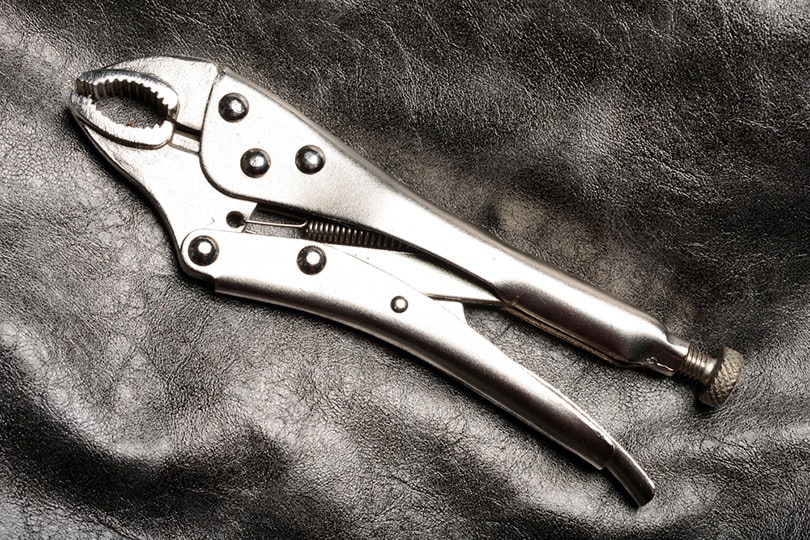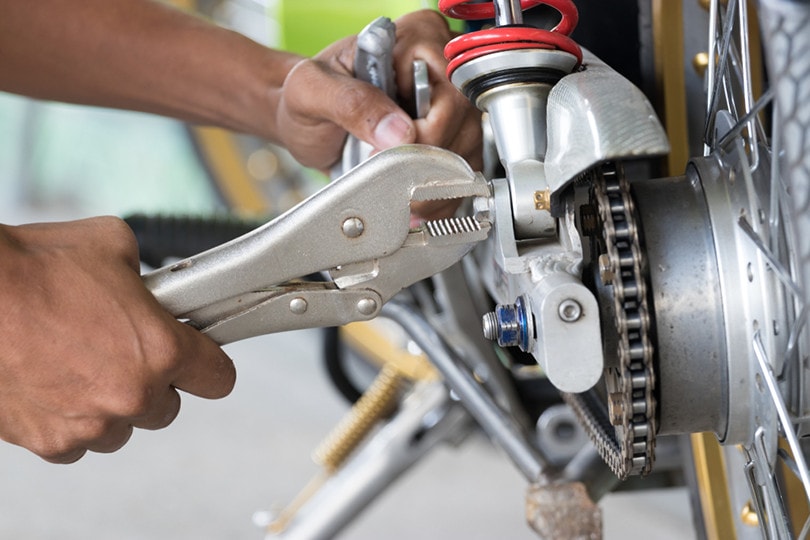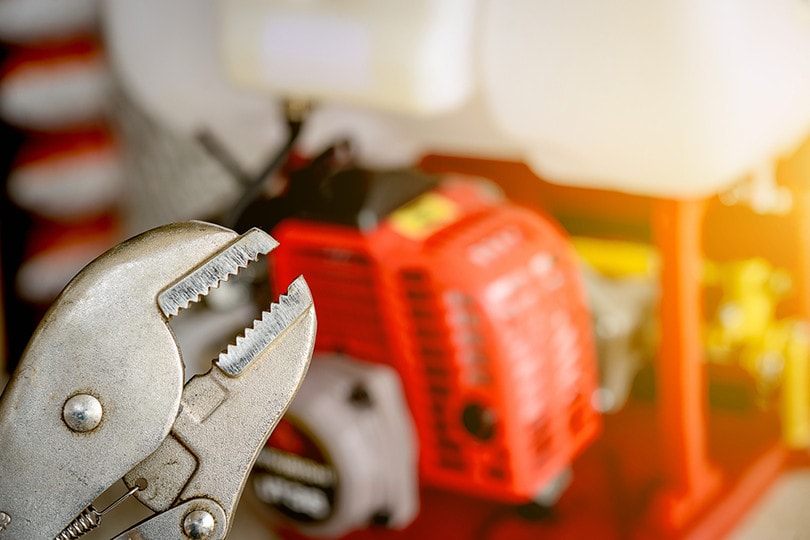How to Use Locking Pliers (Vice Grips): Tips, Tricks & Types
-

- Last updated:

Locking pliers (also known as vice grips) are one of the handiest tools in any DIYer’s tool bag. You may be working on a garage door or a car. You can use vice grips to open stubborn jar lids and remove nails. Also, you can use it to remove screws without damaging their surface. Most importantly, it gives you control over your work.
But, not everyone knows how to use them well. It can be the difference between making it through a project without damaging anything versus starting over from scratch.
We’ll show you how to use locking pliers in this guide. Also, we’ll give you several tips and tricks for using this handy tool. So, whether you’re a professional craftsman or just starting on your hobbies, we hope you find this guide helpful!
What to Do Before You Start
The first thing you need to do is choose the right type of vice grips for your project depending on:
- The material you are working with
- How much force is needed
- The time you need to hold a particular object in place
For example, if you need to hold something in place for a short period, it may be better to use a pair of standard vice grips. They have a small jaw size, and you can use them on small objects.
On the flip side, when working on a project that needs more force or holding power, buy a pair of larger vice grips with large jaws. Many other types of locking pliers are available. We’ll discuss them later in this handy guide. But first, here is the step-by-step guide.

Step-by-Step Process for Using Locking Pliers (Vice Grips)
1. Test If the Jaw Fits Your Workpiece
First, select the jaw size on the locking pliers. Then, insert your workpiece into the jaws. Ensure the piece is well-sized and that the jaws fit around it securely.
If there’s a lock on one of the jaws, unlock it. Then, tighten or loosen its grip on your workpiece. Once you have placed the jaws around your workpiece, squeeze the handles to close the locking pliers.
Both jaws should fit tightly around the workpiece without applying pressure on it. You cannot lock the jaws if they’re too tight. Also, if your workpiece is fragile, don’t apply too much pressure on the handles as this can damage your workpiece.
2. Fine-Tune the Adjustment Bolt
You’ll find the adjustment bolt at the bottom of the fixed handle. It closes and opens the jaws. If your workpiece fits perfectly when you close the locking pliers for the first time, you don’t have to fine-tune the adjustment bolt.
The purpose of the adjustment bolt is to allow you to fine-tune the tension on your lock. You can adjust how tight or loose your lock will be by adjusting this bolt. Spin the adjustment bolt if you want to narrow the jaws. If you want to widen them, rotate them in the opposite direction. Place the jaws around your workpiece once you have fine-tuned them.
Test if it fits, and if not, repeat the procedure. When you squeeze the handles, make sure they click together. This way, the workpiece fits snugly.

3. Pull or Rotate the Workpiece
With the workpiece fitting snugly around the jaws, you can bend, rotate, or pull it with the locking pliers. Use one hand to grasp the locking pliers. Then, use your other hand to pull or rotate the workpiece.
4. Unclamp the Locking Pliers Once You’re Through
Press the release lever against the lower handle to unlock the locking pliers. Some release levers may function the other way around. Instead of pulling them towards the lower handle, pull them away.
When unlocking the locking pliers, you’ll hear a ‘click’ sound when the jaws open. Now you can use your locking pliers for the next project you have.
 Tips and Tricks When Using Locking Pliers (Vice Grips)
Tips and Tricks When Using Locking Pliers (Vice Grips)
- Don’t Expose Locking Pliers to Excess Heat – Locking pliers are made for heavy-duty work, but they can become damaged by heat if used in a hot environment. An open flame such as a kitchen stove, can cause the jaws to expand, making them slip off the part you are trying to grip.
- Lubricate the Joint of the Locking Pliers – If you use locking pliers without lubricating this joint, it can lead to premature wear and tear. Apply light oil or grease on them regularly to ensure that your tool remains in excellent condition and prevent it from getting damaged easily.
- Don’t Force Locking Pliers Beyond Its Capacity – You may damage the locking mechanism if you apply too much force while tightening or loosening the grip. Locking pliers are powerful, but if you force them beyond their capacity, the jaws will bend and break. It makes it challenging for you to use them in the future.
- Use Your Locking Pliers for Its Intended Job Only – Locking pliers are used in situations where the jaws lock together tightly. You can use it when you want to secure two pieces of metal together or when you need to tighten a nut or bolt. Learn how to use your locking pliers for their intended purpose. This way, you can get the most out of it.
 Types of Locking Pliers
Types of Locking Pliers
Perhaps you’re wondering how many types of locking pliers there are. Well, wonder no more! Here they are!
Needle Nose Locking Pliers
These locking pliers have a flat jaw, which you can use to grip the object you are working on. The needle nose locking pliers also have a long shank with a locking mechanism. These locking pliers are ideal for working with bolts or nuts and with thick wires or cables.
Straight Jaw Locking Pliers
These are designed to work in a straight line. They are ideal for twisting wire and holding it in place while working on it. They have a flat jaw designed to hold small objects such as nuts and bolts that require precise control.
Straight jaw locking pliers come in both standard and heavy-duty versions. They’re an ideal alternative to a spanner set. The only downside of these locking pliers is that it’s serrated. So, it can damage delicate surfaces.
C-Clamp Locking Pliers
The C-Clamp vice grips are the most common type of locking pliers. They have a long handle and a wide jaw. With these, you can clamp onto any bolt or nut size. The jaw is also designed to fit well in the palm of your hand.
It’s an ideal choice for tight spaces. You can use them for general-purpose work, but they’re not as effective at holding onto small parts like other types of locking pliers.
They don’t have any teeth on their jaws. So, they won’t get many bites on smaller objects like nuts and bolts.
Hose Pinch Off Locking Pliers
These locking pliers are designed for hose assemblies and other plumbing components. They have a special gripping feature, which allows them to grip the hose tightly without damaging it. They are ideal for use in industrial settings where harsh chemicals are involved.
Adel Clamp Locking Pliers
These pliers have a clamp mechanism that allows you to lock the jaws together and secure work pieces in place while you work on them. The jaws are made of stainless steel and have an adjustable gripping force.
You can use Adel Clamp Locking Pliers for many types of tasks including bending, cutting, and holding. Also, they have a non-slip rubber handle that gives you maximum control over your workpiece.
Locking Chain Clamp Pliers
Locking chain clamp pliers are designed to work with wire, rope, or chain. These pliers have a large jaw area that allows you to insert or remove wire and rope easily. The jaws close around the object, locking it in place for easy removal.
They also have a built-in ratchet mechanism that helps you make tight turns on wire or rope. Also, the handles on these pliers are made from high-quality steel and coated with chrome for durability.
 Uses of Locking Pliers
Uses of Locking Pliers
Clamping
Locking pliers apply a clamping force to a workpiece. It’s helpful when holding workpieces as you work on them, especially when using power tools such as drills and saws. You can also use them when working with other tools that don’t have an adjustable jaw locking mechanism.
Removing Rounded Bolt Heads
The rounded head of a bolt or nut can be challenging to remove using standard pliers. The locking pliers allow you to work on this type of fastener easily. Locking pliers have a special tip that fits into the rounded head, allowing you to remove the bolt.

Removing Drill Bits and Broken Fasteners
You can remove broken drill bits and fasteners in automobiles, trucks, buses, and other machines. Besides, you can use locking pliers to remove bolts and nuts from the engines of cars, trucks, and other machines.
Vice grips allow you to grip the threaded body. It rotates with enough force to remove the broken screw.
Bending and Shaping Metal
You can use locking pliers to bend and shape metal parts. They are helpful because they can hold the object without causing any damage to it. However, they cannot work on heavy-duty, thick metal. You can only bend and shape thin metal using vice grips.
If you have ever tried bending sheet metal with a regular pair of pliers, you know how challenging it can be. The locking pliers solve this problem. They allow you to hold onto the metal while applying pressure on both sides.
 In Conclusion
In Conclusion
When you’re trying to tighten something with a nut and you can’t get enough torque with your hands alone, vice grips can be a great asset. They’re less likely to slip as you turn them against the force of your spanners or ratchets. So, use them in every circumstance where you need more gripping power than is available to your hands.
So, there you have it: the most helpful locking pliers – tips, tricks, and how to use them – all in one place. Now you know how they work and their uses. It’s time to start incorporating these handy tools into your DIY projects.
Featured Image Credit: FtLaud, Shutterstock
Contents

